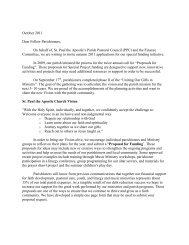Create successful ePaper yourself
Turn your PDF publications into a flip-book with our unique Google optimized e-Paper software.
<strong>Key</strong> <strong>Issues</strong> <strong>in</strong> <strong>VoIP</strong>Roger Hay & Associateshttp://www.rogerhay.caVoice Over IP (<strong>VoIP</strong>) is spread<strong>in</strong>g. What is it, andwhat are the key issues <strong>in</strong> us<strong>in</strong>g and manag<strong>in</strong>g it?What is <strong>VoIP</strong>, Anyway?“<strong>VoIP</strong>” is voice over the Internet Protocol (IP). IPis the basic protocol for carry<strong>in</strong>g data over theInternet. In <strong>VoIP</strong>, voice is digitized, the result<strong>in</strong>gstream of bits is chopped <strong>in</strong>to packets, and thepackets are sent over the Internet us<strong>in</strong>g IP. Whenthe packets arrive at their dest<strong>in</strong>ation, the orig<strong>in</strong>aldata stream is reassembled and decoded to recoverthe voice.The Rise of <strong>VoIP</strong>People have been transmitt<strong>in</strong>g voice over packetnetworks for at least 20 years. More recently,people have been us<strong>in</strong>g the Internet to chat, andnetworks such as Free World Dialup have sprungup to connect them. People have also been us<strong>in</strong>gshared whiteboard, voice and video programs suchas NetMeet<strong>in</strong>g over local area networks and theInternet. These are the harb<strong>in</strong>gers of change.<strong>VoIP</strong> is now mov<strong>in</strong>g <strong>in</strong>to the ma<strong>in</strong>stream andchalleng<strong>in</strong>g exist<strong>in</strong>g value streams.• A significant and grow<strong>in</strong>g portion of lelephonetraffic is shift<strong>in</strong>g to <strong>VoIP</strong>, and operator andmanufacturer focus has shifted to <strong>VoIP</strong>.Global wholesale telephone service prices havefallen to a few cents per m<strong>in</strong>ute on liberalizedroutes.• Local-area-network (LAN)-based <strong>VoIP</strong> has allbut taken over the PBX (private branchexchange) world. Enterprises are <strong>in</strong>tegrat<strong>in</strong>gtheir voice and data networks. Cordless andcellular handsets that use LAN-friendly 802.11WiFi <strong>in</strong> enterprise environments have emerged.• Old and new service providers, <strong>in</strong>clud<strong>in</strong>g cableoperators, have started offer<strong>in</strong>g VoiP serviceover high-speed access l<strong>in</strong>es.Why is <strong>VoIP</strong> Becom<strong>in</strong>g Important?<strong>VoIP</strong> is play<strong>in</strong>g a central role <strong>in</strong> the trend towardnear-zero telephone service costs and the rise ofproductivity-enhanc<strong>in</strong>g applications. Shift<strong>in</strong>g to<strong>VoIP</strong> may be central to bus<strong>in</strong>ess survival this newenvironment.<strong>VoIP</strong> allows the end stations to communicatedirectly with each other after be<strong>in</strong>g l<strong>in</strong>ked up bycentral servers, lead<strong>in</strong>g to simpler, more flexibleand more economical networks that support voice,data and video.In the long-distance telephone space, the firstimpetus for <strong>VoIP</strong> was to bypass high PSTNterm<strong>in</strong>ation fees by us<strong>in</strong>g the Internet. Now,carriers are look<strong>in</strong>g at the advantages of hav<strong>in</strong>g as<strong>in</strong>gle, simpler Next Generation Network for voiceand data with lower service-creation hurdles.Enterprises are attracted by only hav<strong>in</strong>g to manageone set of equipment and wires to the desktoprather than two, be<strong>in</strong>g able to comb<strong>in</strong>e voice, dataand video on a common wide area network, andmak<strong>in</strong>g practical new productivity tools that this<strong>in</strong>tegration enables.The grow<strong>in</strong>g availability of low-cost high-speeddata access services has opened a way for newlocal and long-distance service providers to reachcustomers us<strong>in</strong>g <strong>VoIP</strong>.<strong>Key</strong> <strong>VoIP</strong> Platform ElementsUnless the traffic level is low compared withnetwork bandwidth, typically a quality-controlledand -managed IP network is needed (<strong>in</strong> contrast tothe raw Internet that only provides a best-effortsservice). In a managed network, voice packets aregiven priority (to m<strong>in</strong>imize jitter and delay),network behaviour under congestion is controlled.Copyright © 2004, 2005 Roger Hay & Associates Ltd.cont<strong>in</strong>ued …
<strong>Key</strong> <strong>Issues</strong> <strong>in</strong> <strong>VoIP</strong> (cont<strong>in</strong>ued)Call detail records may need to be gathered andprocessed. Accurate bills need to be generated andpresented on time, and <strong>in</strong>voiced charges collected.Economical ways of do<strong>in</strong>g this at a small fractionof a cent per m<strong>in</strong>ute of use are needed.Productive centralized operations, ma<strong>in</strong>tenance,adm<strong>in</strong>istration and provision<strong>in</strong>g tools are needed.Bus<strong>in</strong>ess plans are needed which re-align and br<strong>in</strong>gtogether the new regulatory and competitivelandscapes, markets, segments, bundles, prices,channels, platforms, operations, settlements,bill<strong>in</strong>g, collections, f<strong>in</strong>ances and profits.Protocols <strong>in</strong> <strong>VoIP</strong>In carrier networks, the emerg<strong>in</strong>g standard for<strong>VoIP</strong> is SIP (Session Initiation Protocol).The ITU-T H.323 suite of standards is common onlocal area networks, and is supported by manyPBXs and used by applications such asNetmeet<strong>in</strong>g.MGCP (Media Gateway Control Protocol) is usedto control <strong>in</strong>terwork<strong>in</strong>g devices at the edges of themanaged IP networkMarket Structure, Technical and Regulatory<strong>Issues</strong>The old market and regulatory structure ischang<strong>in</strong>g. Voice service prices have fallen to thepo<strong>in</strong>t where, on liberalized routes, charges set byregulators to defray local <strong>in</strong>cumbent service costsnow dom<strong>in</strong>ate regardless of distance, <strong>in</strong>creas<strong>in</strong>gthe pressure on the “last mile” cost bottleneck.<strong>VoIP</strong> is play<strong>in</strong>g a central role. How theopportunities and challenges are addressed by newentrants, <strong>in</strong>cumbents, manufacturers and regulatorswill decide the new market and regulatorystructure.Select the right codec(s). Some high compressionalgorithms, that squeeze voice <strong>in</strong>to a low bit rate tosave bandwidth, sound bad and <strong>in</strong>troduce delay,and should be avoidedVoice dislikes jitter. Jitter is rapid changes <strong>in</strong> thetransit delay between speaker and listener. A lowdelaytransport network, and buffer<strong>in</strong>g at thereceive end, are needed.Voice dislikes delay. Delays of more than about100 milliseconds will <strong>in</strong>terfere with conversation.In <strong>VoIP</strong>, low-bit-rate encod<strong>in</strong>g and IP queu<strong>in</strong>gdelays can easily build up to this amount andbeyond, so it is important to manage encod<strong>in</strong>g anddelay with<strong>in</strong> acceptable limits.Voice dislikes echo. Virtually all of the telephoneson the public switched telephone network are twowire,which means that some of the receivedspeech energy gets reflected back to the talker asecho. Users f<strong>in</strong>d delayed echoes highlyobjectionable. For delays typical of <strong>VoIP</strong>, echocancell<strong>in</strong>g is needed.Excessive transcod<strong>in</strong>g degrades voice. If there aretoo many conversions from one voice encod<strong>in</strong>gstandard to another <strong>in</strong> a call (<strong>in</strong>clud<strong>in</strong>g voice mailrecord<strong>in</strong>g and playback), the result<strong>in</strong>g sound isdistorted, so the total quantity of transcod<strong>in</strong>gs <strong>in</strong>the speech path must be managed.Legal wiretapp<strong>in</strong>g may impact economics. One ofthe advantages of SIP is that it allows end stationsto talk directly to each other after call setup. If itturns out that central servers must rema<strong>in</strong> <strong>in</strong> thecall after setup <strong>in</strong> order to do legal wiretapp<strong>in</strong>g,then this may impact the economics of <strong>VoIP</strong>.For further <strong>in</strong>formation, please contactRoger Hayroger@rogerhay.caTelephone +1 (905) 616-4429Roger Hay & Associates1272 Elg<strong>in</strong> CrescentOakville, Ontario, Canada L6H 2J7Tel +1-905-616-4429http://www.rogerhay.caE-mail <strong>in</strong>fo@rogerhay.ca
















